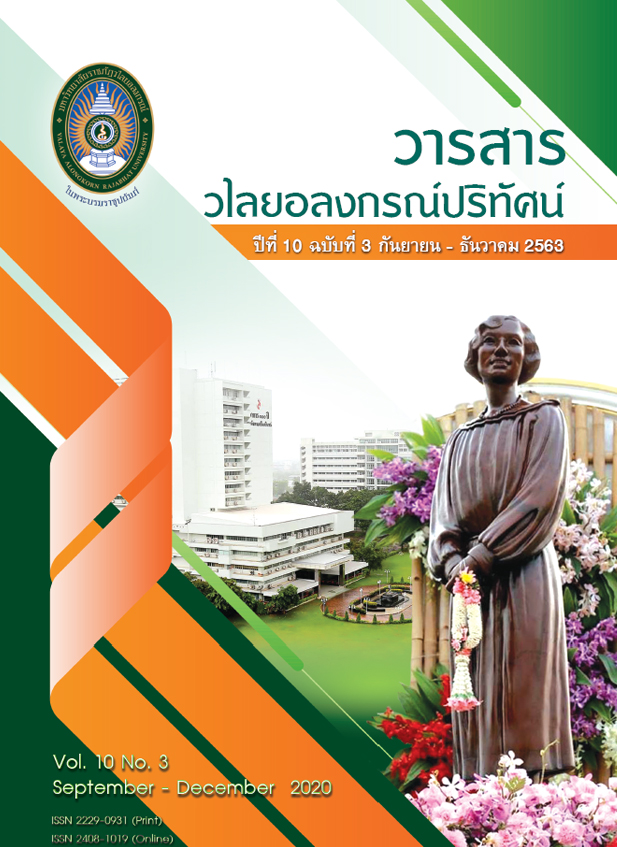การวิเคราะห์องค์ประกอบเชิงยืนยันความฉลาดรู้ด้านการอ่าน สำหรับนักเรียนชั้นมัธยมศึกษาตอนต้น
คำสำคัญ:
การวิเคราะห์องค์ประกอบเชิงยืนยัน, ความฉลาดรู้ด้านการอ่านบทคัดย่อ
งานวิจัยนี้เป็นวิจัยเชิงปริมาณ มีวัตถุประสงค์เพื่อวิเคราะห์องค์ประกอบเชิงยืนยัน ความฉลาดรู้ด้านการอ่านสำหรับนักเรียนชั้นมัธยมศึกษาตอนต้น กลุ่มตัวอย่างที่ใช้ในการศึกษา คือ นักเรียนชั้นมัธยมศึกษาตอนต้น สังกัดสำนักงานเขตพื้นที่การศึกษามัธยมศึกษาเขต 7 โดยผู้วิจัยใช้เกณฑ์ของการกำหนดขนาดกลุ่มตัวอย่าง คือ ขนาดกลุ่มตัวอย่างเท่ากับ 20 เท่า ต่อตัวแปรที่สังเกตได้ 1 ตัวแปร โดยในงานวิจัยมีตัวแปรที่ศึกษาทั้งหมด 5 องค์ประกอบ 21 ตัวแปรสังเกตได้ ดังนั้น จึงกำหนดขนาดกลุ่มตัวอย่างจริง 420 คน เครื่องมือในการเก็บข้อมูลเป็นแบบสอบถามมีค่าอำนาจจำแนกอยู่ระหว่าง 0.28 ถึง 0.71 และความเชื่อมั่นของแบบสอบถามโดยใช้วิธีสัมประสิทธิ์แอลฟ่าของครอนบาค มีค่าระดับความเชื่อมั่นเท่ากับ 0.94 แสดงว่าเครื่องมือมีความเชื่อมั่น และ ความเที่ยงตรงระดับดี และสถิติที่ใช้ในการวิเคราะห์ข้อมูล ได้แก่ ค่าพิสัย ส่วนเบี่ยงเบนมาตรฐาน ความเบ้ ความโด่ง และการวิเคราะห์องค์ประกอบเชิงยืนยันอันดับสอง
ผลการศึกษาพบว่า ความฉลาดรู้ด้านการอ่านสำหรับนักเรียนชั้นมัธยมศึกษาตอนต้นประกอบด้วย 5 องค์ประกอบ ได้แก่ ด้านการค้นคืนและเข้าถึงสาระ ด้านการบูรณาการและ การตีความ ด้านการสะท้อนและประเมิน ด้านการนำผลการอ่านไปใช้ ด้านความรักและความผูกพันกับการอ่าน ทั้งนี้โมเดลที่พัฒนาขึ้น มีความสอดคล้องกับข้อมูลเชิงประจักษ์อยู่ในเกณฑ์ดี โดยมีค่าดัชนี ความกลมกลืนผ่านเกณฑ์ที่กำหนดไว้ทุกตัว
เอกสารอ้างอิง
บุญชม ศรีสะอาด. (2553). การพัฒนาการสอน. กรุงเทพฯ: สุวีริยาสาส์น.
สันติวัฒน์ จันทร์ใด. (2559). รูปแบบการเรียนการสอนตามแนวการสอนประสบการณ์การอ่าน แบบเสริมต่อการเรียนรู้แบบกำกับตนเองเพื่อส่งเสริมการเรียนรู้เรื่องการอ่านของนักเรียนระดับชั้นมัธยมศึกษาตอนต้น. วิทยานิพนธ์ครุศาสตรดุษฎีบัณฑิต สาขาวิชาหลักสูตรและการสอน จุฬาลงกรณ์มหาวิทยาลัย.
สำนักงานราชบัณฑิตยสภา. (2562). พจนานุกรมศัพท์ศึกษาศาสตร์ร่วมสมัยชุดความฉลาดรู้ (Literacy). กรุงเทพฯ: อรุณการพิมพ์.
สำนักงานเลขาธิการสภาการศึกษา. (2562). กรอบสมรรถนะหลักผู้เรียนระดับการศึกษาขั้นพื้นฐาน. กรุงเทพฯ: โรงพิมพ์บริษัท 21 เซ็นจูรี่.
สำนักทดสอบทางการศึกษา. (2560). ผลการประเมินคุณภาพผู้เรียนระดับชาติ ปีการศึกษา 2560 บทสรุปและข้อเสนอแนะเชิงนโยบาย. กรุงเทพฯ: โรงพิมพ์ชุมนุมสหกรณ์การเกษตรแห่งประเทศไทย.
Bollen, K. A. (1989). Structural equations with latent variables. New York: John Wiley & Sons.
Browne, M. W. & Cudeck, R. (1993). Alternative ways of assessing model fit, in Testing Structural Equation Models, ed. K. A. Bollen and Long. S., Newbury Park CA: Sage.
Diamantopoulos, A., & Siguaw, A. D. (2000). Introducing LISREL: A guide for the uninitiated. London: Sage Publications.
Hair et al. (2006). Multivariate data analysis. (7th ed.). New Jersey: Pearson Education International.
Kline, R. B. (2011). Principles and practice of structural equation modeling. (3rd ed.). New York: The Guilford Press.
Mueller, R. O. (1996). Basic Principles of Structural Equation Modeling. An Introduction to LISREL and EQS. New York: Springer-Verlag.
Sorbon, D. (1996). LISREL 8: User's Reference Guide. Scientific Software International
NAEP (2013). Reading framework for the 2013 National Assessment of Educational Progress. New York: PISA.
OECD. (2018). Thailand - Country Note - PISA 2018 Results. Paris: PISA.
PIRILS. (2015). Reading Literacy. Australia: PISA
ดาวน์โหลด
เผยแพร่แล้ว
รูปแบบการอ้างอิง
ฉบับ
ประเภทบทความ
สัญญาอนุญาต
ข้อความที่ปรากฏในบทความแต่ละเรื่องในวารสารวไลยอลงกรณ์ปริทัศน์ เป็นความคิดเห็นของผู้นิพนธ์แต่ละท่าน มิใช่เป็นทัศนะและมิใช่ความรับผิดชอบของกองบรรณาธิการจัดทำวารสาร และ
มหาวิทยาลัยราชภัฏวไลยอลงกรณ์ ในพระบรมราชูปถัมภ์


